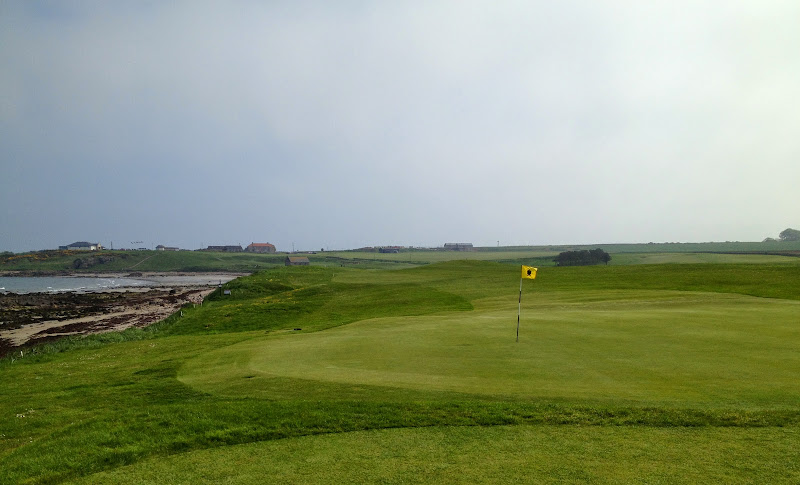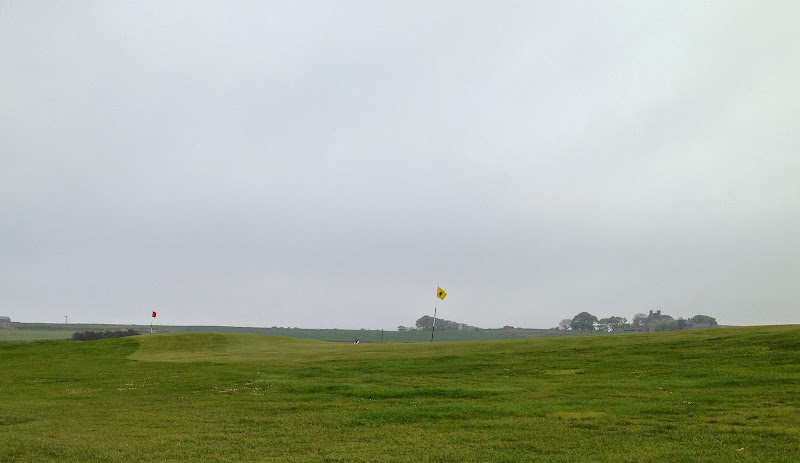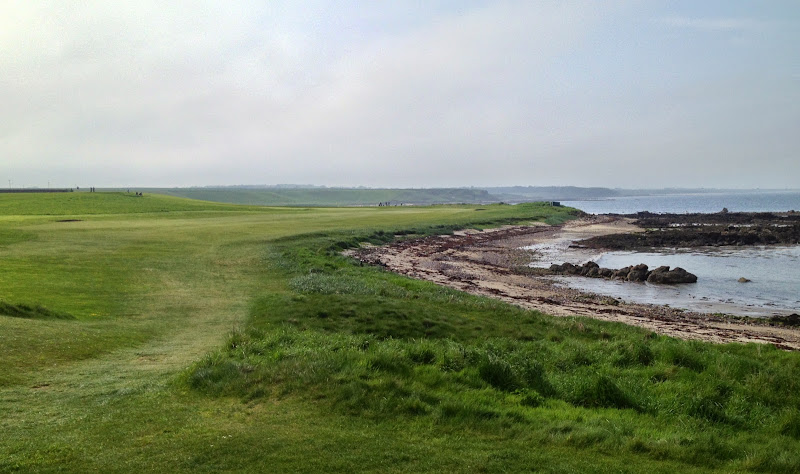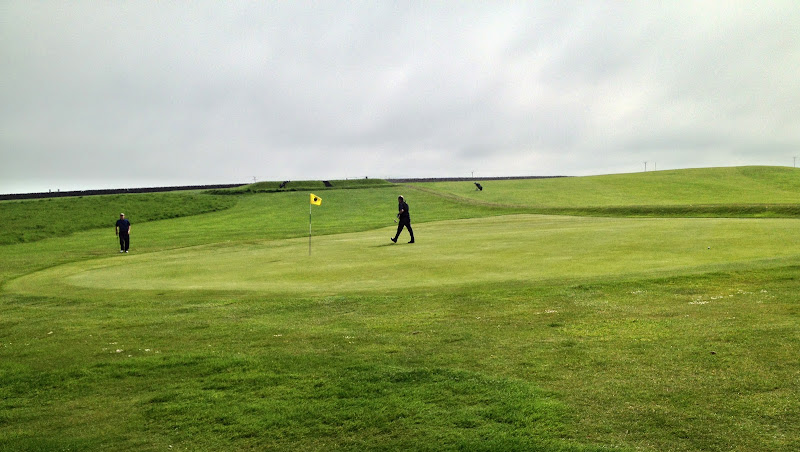I've finally found more time to type up my handwritten notes on a trip (mostly) to Scotland, and resume with a new thread to save some bandwidth cost for Ran and all of you who read the site using 4G.
Other posts on courses from this trip can be found at the following links (first three are in the same thread):
Pasatiempo Golf Club:
http://www.golfclubatlas.com/forum/index.php/topic,58052.msg1379095.html#msg1379095Extremely limited perspective on golf in mainland China:
http://www.golfclubatlas.com/forum/index.php/topic,58052.msg1380004.html#msg1380004Royal Aberdeen Golf Club:
http://www.golfclubatlas.com/forum/index.php/topic,58052.msg1386159.html#msg1386159Eden, New, and Himalayas, St. Andrews:
http://www.golfclubatlas.com/forum/index.php/topic,59497.0.html------
The Crail Golfing Society is the seventh oldest golf club in the world, and its members have played on the Balcomie Links since the 19th century. Old Tom Morris had a hand in the routing at one point, but as I noted in another thread earlier in the summer, a series of interesting routing maps in the clubhouse restaurant reveals that Balcomie's routing changed several times between 1895 and 1907. (Hopefully, some future visitor can snap a photo of that display and post it here.) Certainly, Balcomie stands at present as an interesting course in its own right, and also as a historical specimen from days gone by when courses were not as crowded and balls did not fly as far. The course's current routing, a figure-8 plus a filing cabinet, is a tremendous use of the 80 or so acres fronting the North Sea. When one wonders what could have happened with more land and modern construction techniques, one need look no further than Kingsbarns a few miles away. These two courses sharply contrast one another and provide completely different experiences that appeal in different ways.
The first 14 holes of Balcomie are played along a barren stretch of land between farms and the North Sea. All of these fairways are shared or could be shared with different mowing patterns, and there is no thick rough through the green. The tightness of these holes creates something of a safety issue and also seriously slows play, at least during the afternoon block of visitor times during which I played. (In blatant violation of several principles of modern design, the final 6 holes include 3 par 3s and 2 par 3.5s, and there are numerous instances on the first 12 holes where lines of play are dangerously close to the tee boxes of other holes.) For me, all this just added to the character and unique experience of a round on Balcomie, and this routing surely makes for a better golf course than one (a) spread out onto more inland farmland or (b) confined to a length of about 4500 yards, as the 18-hole course was originally designed. At least two members of my family were fairly annoyed by the shared fairways and slow play, and I know that the close corridors would be a lot less charming if it didn't bring players so close to the sea on every shot.
This view, from the putting green, shows the 13th tee and several other fairways on the narrow strip of land between the farms and the sea:

The most thrilling holes at Balcomie are, not surprisingly, those along the sea, but several of the other holes are of particular interest, too. The first tee shot (Boathouse, 322/313/305) is played off the Craighead bluff, 45 feet above the green. A deceptively placed bunker is placed some 20 yards short of the green, a berm is just short of the green, and a burn behind the green punishes wedges hit too hard. A great opening hole, it offers the only chance up one's guard and push a tee shot until the 11th hole.
On the second hole, Over the Knowe (493/451/440), visual confusion ensues. From the white tee, the flag was hidden from view the day we played, and we all played our tee shots as if the 8th/11th green to the left, away from the sea, was our target. The hole doglegs right along the shore, and a large knoll on the left side of the (true) fairway about 100 yards short of the green obscures the view from certain angles and complicates third shots--this feature plays an important role in strategy for both the first and second shots, as the Road Hole bunker is reputed to do.
View from behind the second green:

Edit: The above photo gives a much better sense of the intimate/cramped nature of the property than I earlier realized. I took it from the third tee, which you can see a foot or so away from the fringe of the second. In the distance, past the old boathouse, you can see the cliff above which the 13th green is perched. To the right of the stand of trees is the 10th green. Between the second fairway and the 10th are two other fairways (the 11th and 12th)!
The third hole (The Briggs, 177/168/155) is a semi-blind par 3 with the green perched on the edge of a gentle cliff. Shots should not be played right of the flag; the cliff cuts in further to the left and the green narrows as it deepens, while shots played slightly to the left are likely to get a good bounce onto the green. Adding to the intrigue, the left edge of the green also contains part of that slope toward the water:

Alas, interesting green contours are relatively uncommon at Balcomie, with the most interesting greens side-by-side at the 3rd and 8th/11th, seen below:

The fourth (Fluke Dub, 354/315/274) and fifth (Hell's Hole, 447/439/427) are both dogleg-right Cape holes, with the second half of the fifth built on land acquired for the course around 1994. The shorter fourth does not require a particularly aggressive line from the tee box we played left of the third green (there is another on the cliff edge to the right that surely makes for an even more exciting hole):

The fifth lives up to its name. I hit my drive as aggressively as possible and straight downwind, and was still left with a 6-iron into the flattish green.
Fifth tee shot:

Fifth green:

Turning back toward the clubhouse and slightly inland, the only very notable hole in the middle of the round is the 7th (North Carr, 346/273/264), where the fairway drops off about 220 yards from the tee and the second shot is played over an old boundary wall or dyke not dissimilar from the 14th at Royal Aberdeen. The green slopes away from the fairway with the natural slope:

As mentioned, the 9th through 12th fairways are essentially shared, with light rough between, and the pace of play slows down tremendously from this point forward. To give a sense of the tightness, note that in the above photograph, two golf carts are resting beside the 8th tee, dangerously near the landing zone for the 7th.
My camera/phone ran out of batteries while I was on the 12th tee, so I am not able to share any photos of the brilliant closing stretch of holes. If you haven't experienced them, the lack of photos will allow you to be even more surprised and astounded to see the 13th through 16th. The 13th (Craighead, 214/207/201) a par 3 so difficult that a sign advises players to wave up the next group before putting out, is a semi-blind hole played up and over a 30-foot cliff onto the Craighead. The 14th (The Cave, 147/141/132) returns to the coast and plays down off the Craighead again, with a 30-foot drop. The sea on the right makes the hole reminiscent of the 7th at Pebble, except a bit longer and with a larger green and deeper bunkers (as far as I can tell; I've only walked Pebble as a spectator).
14th green, viewed from the first fairway:

The last four holes are played over a different stretch of links east of the clubhouse and southeast of the other 14 holes. A walk of 300 yards from the pervious green is necessary to reach it, but what a walk! I was so busy enjoying the view of the waves crashing into the rocks that I didn't notice the cave in the cliff face where a king named Constantine was supposedly killed. The reference to Highlands Links is obligatory, but as compared with a pleasant walk through the woods along a stream, the path at Balcomie is a special and even surreal setting in the world of golf.
As a par 4, the 15th (Mill Dam, 264/254/245) would be an unremarkable hole except for its setting. Thinking of it instead as a par 3.25, and considering that a pulled tee shot is out of bounds on the beach, it's rather stronger. The cove behind the green is gorgeous, featured repeatedly in the club's promo materials. The final hole of great interest is the 16th, (Spion Kop, 162/157/152), a shorter and slightly less dramatic version of the 13th. Despite that it's actually a template hole and not even unique on this golf course, the hole is a real treat for this American golfer raised on courses with considerably less architectural variety.
Balcomie was a priority for me in planning my first trip to Scotland because I wanted to be sure to see at least one course that gets little international attention except among GCA readers. The seaside and cliff-top holes I've described intrigued me greatly and were much more dramatic than I anticipated from looking at the overheads and other photos. Another reason for giving it priority was that I was simply curious to see how the routing over just 80 acres worked. Could it be a better course if extended further up or down the coast so that the sea was in play on 7 or 8 holes instead of 6? Perhaps. Could it be a better experience today if just 15 holes instead of 18, skipping the 9th through 11th holes? Probably. But all in all, my day at Balcomie was exceptional, much more than just a gentle introduction to links golf in a pleasant location an instead a genuinely exciting golf course on a terrific piece of property.